Abstract
The quasi-two-dimensional molecular conductor α-(BEDT-TTF)2I3 exhibits anomalous transport phenomena where the temperature dependence of resistivity is weak but the ratio of the Hall coefficient at 10 K to that at room temperature is of the order of 104. These puzzling phenomena were solved by predicting massless Dirac fermions, whose motions are described using the tilted Weyl equation with anisotropic velocity. α-(BEDT-TTF)2I3 is a unique material among several materials with Dirac fermions, i.e. graphene, bismuth, and quantum wells such as HgTe, from the view-points of both the structure and electronic states described as follows. α-(BEDT-TTF)2I3 has the layered structure with highly two-dimensional massless Dirac fermions. The anisotropic velocity and incommensurate momenta of the contact points, ±k0, originate from the inequivalency of the BEDT-TTF sites in the unit cell, where ±k0 moves in the first Brillouin zone with increasing pressure. The massless Dirac fermions exist in the presence of the charge disproportionation and are robust against the increase in pressure. The electron densities on those inequivalent BEDT-TTF sites exhibit anomalous momentum distributions, reflecting the angular dependences of the wave functions around the contact points. Those unique electronic properties affect the spatial oscillations of the electron densities in the vicinity of an impurity. A marked behavior of the Hall coefficient, where the sign of the Hall coefficient reverses sharply but continuously at low temperatures around 5 K, is investigated by treating the interband effects of the magnetic field exactly. It is shown that such behavior is possible by assuming the existence of the extremely small amount of electron doping. The enhancement of the orbital diamagnetism is also expected. The results of the present research shed light on a new aspect of Dirac fermion physics, i.e. the emergence of unique electronic properties owing to the structure of the material.
Introduction
In quasi-two-dimensional organic conductors, bis(ethylene dithiolo)tetrathiofulvalene (BEDT-TTF) salts [Citation1], a large degree of freedom for arrangement and rotation of molecules gives rise to the emergence of various electronic states, such as superconductivity [Citation2] and charge ordering [Citation3]. Among many salts, the α-(BEDT-TTF)2I3 (α phase of BEDT-TTF tri-iodide) synthesized by Bender [Citation4] is of particular interest, because it exhibits a rich phase diagram containing three unconventional electronic states, i.e. the stripe charge ordering, the superconductivity in the presence of charge ordering, and the zero-gap state (ZGS).
The metal–insulator transition was observed at TMI=135 K at ambient pressure [Citation4]. The magnetic susceptibility measurement at ambient pressure shows a rapid decrease at temperatures below TMI indicating a nonmagnetic state with a spin gap [Citation5]. The origin of the insulator phase has been studied theoretically using the mean field approximation [Citation6–9], and the stripe charge ordering was proposed by introducing the extended Hubbard model with the on-site and nearest-neighbor Coulomb interaction [Citation7]. From the nuclear magnetic resonance (NMR) experiments [Citation10] and the angular dependence of 13C-NMR line shape, it was confirmed that the charge stripes run along the direction perpendicular to the a-axis [Citation11]. The charge disproportionation that exists even above TMI develops as temperature decreases from room temperature to TMI [Citation12]. The Raman studies suggest the charge ordering in the insulating phase below TMI and also charge disproportionation above TMI [Citation13, Citation14]. Recent theoretical results on the charge disproportionation [Citation15] are consistent with the x-ray experiment and NMR experiment [Citation16, Citation17].
By adopting an experimental technique of uniaxial strain [Citation18], it was observed that the superconductivity with the critical temperature Tc∼7 K emerges under the pressure (∼2 kbar) along the a-axis [Citation19]. The mechanism of such superconductivity was investigated using the extended Hubbard model [Citation20]. The paring mechanism that is mediated by the spin fluctuation has been maintained and interpreted in terms of the self-doped pseudo-one-dimensional Heisenberg chain.
In 1992, Kajita et al found anomalous transport phenomena in α-(BEDT-TTF)2I3, where the resistivity in the conducting BEDT-TTF plane exhibits weak temperature dependence but the Hall coefficient exhibits strong temperature dependence under high pressure, 14.7 kbar [Citation21]. The Hall coefficient at low temperatures become 105–106 times larger than those at room temperature [Citation19, Citation22–24]. Then it was called narrow-gap semiconductor, because it has the properties of both a metal and a semiconductor [Citation19].
The band structure has been examined using the extended Hückel molecular orbital calculation based on the structure analysis by x-ray diffraction. The semi-metallic band structure with hole and electron pockets is obtained at ambient pressure [Citation25, Citation26], although the insulator phase is observed at low temperatures. The volumes of the hole and electron pockets decrease under a-axis pressure while the volume of the hole pocket increases under b-axis pressure [Citation27]. The electronic states of α-(BEDT-TTF)2I3 at higher pressures are investigated theoretically [Citation20, Citation28, Citation29] to study the mechanism of the superconductivity. It is suggested that an unconventional state exists at pressures higher than a critical pressure where the charge ordering disappears. The density of states (DOS) in the unconventional state is proportional to |∊| with ∊ being the energy measured from the chemical potential. By extending this calculation, the energy dispersion of such electronic state is investigated theoretically using the transfer energies estimated from the experimental data under uniaxial pressure [Citation27], then the Dirac cone dispersion is predicted [Citation30, Citation31]. It is the ZGS where the chemical potential coincides with the contact points of two cones facing each other. The existence of the ZGS is verified by first-principles calculations [Citation32, Citation33], which suggest the ZGS at ambient pressure. The tilted Weyl equation is proposed as the effective Hamiltonian describing the motion of electrons and holes in the vicinity of the contact point [Citation34]. This equation reveals that the extremely anisotropic velocity of the massless Dirac fermion originates from the tilting of the axis of the isotropic cones.
The first discovery of Dirac fermion in condensed matter physics was in graphite [Citation35]. The motions of electrons obey the Weyl equation that was used for neutrino, although the velocity is of the order of 10−3 of the light velocity [Citation36–38]. Anomalous properties in transport phenomena, i.e. the Hall effect [Citation39, Citation40], absence of the backward scattering [Citation41], and universal conductivity [Citation42, Citation43], have been elucidated on the bases of this equation in the context of a single layer in graphite structure, graphene [Citation44]. The interband effects of vector potential have been elucidated for anomalous orbital diamagnetism and Hall effect in a weak magnetic field [Citation45]. On the other hand, electrons in bismuth are described using the tilted Dirac equation [Citation46] with small band gap and anisotropic velocities. The large diamagnetism of bismuth is due to the interband effects of magnetic field in these particular circumstances [Citation47]. Electrons in the HgTe quantum well also obey the Dirac equation for either the zero-gap or the finite gap depending on the thickness of the quantum well [Citation48].
Compared with the conventional Dirac fermions, the ZGS of α-(BEDT-TTF)2I3 has several unique features. It has the layered structure with a highly two-dimensional electronic system. The interlayer transport phenomena, such as the interlayer magnetoresistance [Citation49] and the interlayer Hall effects [Citation50], exhibit many interesting behaviors. Particularly, it was theoretically shown that the strong negative interlayer magnetoresistance is due to the zero-mode Landau Level of the massless Dirac fermion [Citation51]. NMR is also a powerful tool as introduced later. Low symmetry of the crystal due to the variety of transfer energies is also an important feature. The inequivalency of the BEDT-TTF sites (A(=A′)≠B≠C shown in figure ) in the unit cell breaks point symmetries except the inversion symmetry. Tilting of the cones and the incommensurate contact point originate from the low symmetry. The tilting decreases the effective velocity of the cones [Citation52].
Figure 1 Model for the electronic system of α-(BEDT-TTF)2I3 [Citation3, Citation25]. The unit cell enclosed by a dotted line consists of four BEDT-TTF molecules with seven transfer energies ta1, ta2, ta3, tb1, tb2, tb3, tb4 and two kinds of nearest-neighbor repulsive interaction, Va and Vb corresponding to a and b directions. The a- and b-axes in the original notation [Citation25, Citation26] correspond to the y- and x-axes in this paper.
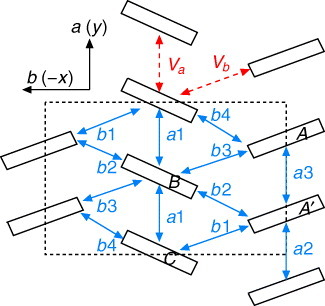
Here, we note that the charge ordering is distinguished from the charge disproportionation as follows. The long-range ordering of charge induced by Coulomb interaction is called charge ordering. It accompanies the phase transition with symmetry-breaking. The difference in charge among the BEDT-TTF molecules in the unit cell, which comes from the inequivalency of those molecules, is called charge disproportionation. The inequivalency of molecules comes from the transfer energies or the local potential of anions. Then the charge disproportionation does not break any symmetry of crystal and does not have any phase transition. Recent theoretical results on the charge disproportionation [Citation15] are consistent with the x-ray experiment [Citation16] and NMR experiment [Citation17]. The charge disproportionation exists in the ZGS theoretically [Citation34]. The low symmetry induces the unconventional momentum distribution of the electron density in the vicinity of the contact point [Citation34]. Moreover, many other variations of zero-gap organic conductors have been discovered [Citation53]. Those unique features are expected to promote a new aspect of Dirac fermion physics.
The puzzle in the transport phenomena has been studied theoretically on the basis of the ZGS concept. The weak temperature dependence of resistivity is demonstrated using total band structure [Citation54] and the relation between the quantum conductance in graphene [Citation43] is discussed. Recently, a sharp but continuous change of the sign of the Hall coefficient has been observed at low temperatures [Citation24]. To study the anomalous temperature dependences of the Hall coefficient, the Hall and electric conductivities are investigated theoretically for the massless Dirac electrons described using the tilted Weyl equation. The strong enhancement of the Hall coefficient toward low temperatures is shown [Citation55] by taking the interband effects of magnetic field exactly into account in the Luttinger–Kohn representation and using the expected temperature dependence of the chemical potential [Citation33]. The sharp but continuous reversal of the sign of the Hall coefficient is possible if the extremely small amount of electron doping, approximately 1 ppm, exists. These results can explain the very anomalous features of the Hall coefficient mentioned above. In addition, it is shown that the orbital diamagnetism has a peak at a temperature where the Hall coefficient reverses the sign. The strong temperature dependences of both the Hall coefficient and orbital diamagnetism are due to the interband effects of magnetic field.
In section 2, we describe the electronic states under pressure of α-(BEDT-TTF)2I3. The electronic properties of ZGS are shown in section 3. The anomalous transport phenomena and orbital diamagnetism are described in section 4. A summary is given in section 5.
Electronic states under pressure of α-(BEDT-TTF)2I3
Hamiltonian and mean field theory
The basic model describing the two-dimensional electronic system in α-(BEDT-TTF)2I3 is shown in figure [Citation3, Citation25]. The unit cell consists of four BEDT-TTF molecules with sites A, A′, B and C. There are six electrons in the four molecules, i.e. the 3/4-filled electronic system. The extended Hubbard model with the on-site repulsive interaction U and the anisotropic nearest-neighbor repulsive interaction Vαβ is given by [Citation3, Citation28]
where i and j denote site indices of the unit cell, and α and β (=A, A′, B and C) are indices of BEDT-TTF sites in the unit cell. The unit of energy is eV hereafter. In the first term, a†iασ denotes a creation operator with spin σ(=↑, ↓) and tiα;jβ is the transfer energy between the (i, α) site and (j, β) site. The transfer energies under the uniaxial pressure (Pa) along the a-axis is estimated using the extrapolation formula
The transfer energies tX and coefficients KX are given using the data at Pa=0 kbar [Citation25] and at Pa=2 kbar [Citation27], where ta1(0)=−0.028, ta2(0)=0.048, ta3(0)=−0.020, tb1(0)=0.123, tb2(0)=0.140, tb3(0)=−0.062, tb4(0)=−0.025 (eV) and Ka1=0.089, Ka2=0.167, Ka3=−0.025, Kb1=0, Kb2=0.011, Kb3=0.032, Kb4=0 (eV kbar−1). The charge ordering is calculated using the mean field theory [Citation6–8, Citation28], where the Hamiltonian is given by
where
and
(i.e. independent of the site i),
, and δ denotes the vector representing the nearest neighbor of the unit cell. The Hamiltonian (Equation3
) is diagonalized by
where ξrσ are the eigenvalue with the descending order, ξ1σ(k)>ξ2σ(k)>ξ3σ(k)>ξ4σ(k), and dαrσ(k) (r=1, 2, 3, 4) are the corresponding eigenvectors. In terms of equation (Equation6
), the number of electrons on α-site with spin σ is given by
where T is the temperature and the Boltzmann factor kB is taken as 1. Equation (Equation7
) is the self-consistent equation for nασ. The chemical potential μ is determined by
Electronic states under pressure
We take Va being larger than Vb to obtain horizontal stripe pattern [Citation7, Citation11]. The phase diagram obtained from the mean field theory is shown in figure on the plane of Pa and Va with U=0.4, Vb=0.05, and T=0 [Citation20]. The charge-ordered insulator exists for large Va (Va>0.167 at ambient pressure) and the charge-ordered metal appears continuously on the dashed line with decreasing Va or increasing Pa. The charge orderings appearing in both those two phases are the horizontal stripe, and do not exhibit any phase transitions between them. Recent theoretical estimation on charge on each site [Citation15], based on the transfer energies obtained by the first-principles calculation [Citation33], is consistent with both the x-ray experiment [Citation16] and the NMR experiment [Citation12], where the A and B sites are hole-rich and the A′ and C sites are electron-rich. The ZGS emerges with a further increase of Pa. The phase transition from the metal to the ZGS is of the first order. The charge disproportionation due to the inequivalency of A(=A′), B and C sites exists in the ZGS. The charges of A and A′ sites are equivalent, because the inversion symmetry is not broken. The tendency that the B site is hole-rich and the C site is electron-rich is similar to that of the charge ordering. We emphasize that there are no long-range orders in this phase. The dotted blue line with Va=0.17 is used to explain the Pa dependences of the electronic states observed in α-(BEDT-TTF)2I3 [Citation23].
Figure 2 Phase diagram on the plane of Pa and Va with U=0.4, Vb=0.05, and T=0 [Citation20]. The dashed line denotes the boundary between the charge-ordered insulator and charge-ordered metal. The solid line denotes the boundary between the charge-ordered metal and ZGS.
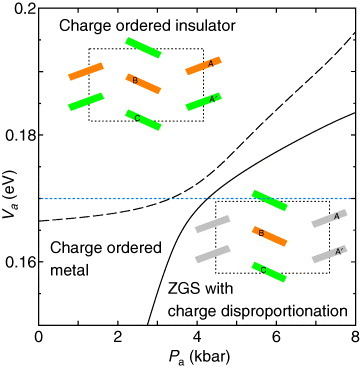
Figure (a) shows the Pa dependences of the band gap between the conduction and valence bands (filled circles) and the superconducting transition temperature Tc (open circles) with U=0.4, Va=0.17, and Vb=0.05 [Citation20]. The positive gap indicates the insulator, and the negative gap indicates the metal owing to the overlap of the conduction and valence bands. In the ZGS, the gap is always zero, indicating the robustness of the ZGS with varying pressure [Citation31]. If the inversion symmetry is retained under some change in the transfer energies, the point degeneracy of those bands is topologically protected, while the contact points move in the first Brillouin zone. The superconductivity in the presence of the charge ordering, which is mediated by the spin fluctuation on the hole-rich chains, occurs in the charge-ordered metal [Citation20], where the Tc is determined using the linearized gap equation for the superconductivity mediated by both the spin and charge fluctuations that are calculated by the random phase approximation on the basis of the site representation using the electronic states given by the mean-field theory. The Tc corresponds to the absolute value of the negative gap, and thus corresponds to the carrier density. We note that the staggered magnetic moments along the hole-rich sites (A and B) exist in the mean-field solution in both the charge-ordered insulator and charge-ordered metal phases, although the temperature dependence of the magnetic susceptibility indicates the spin-singlet formation at ambient pressure [Citation5]. The singlet formation of the spins on the hole-rich sites in the insulator phase is expected if the strong correlation effect owing to the on-site Coulomb interaction U and the difference between the transfer energies tb2 and tb3 (see figure ) are introduced. In the charge-ordered metal phase, however, the singlet is expected to be delocalized by the carriers in the sense of the resonance valence bond [Citation56] resulting in the singlet superconductivity. Figure (b) shows the energy dependences of the DOS of the charge-ordered insulator at Pa=2 kbar (dashed line), the charge-ordered metal at Pa=4 kbar (solid line), and the ZGS at Pa=6 kbar (dot-dashed line) with U=0.4, Va=0.17, and Vb=0.05. The superconductivity in the presence of the charge ordering occurs using the finite DOS near ω=0. The DOS in the ZGS exhibits the characteristic V-shaped energy dependence.
Figure 3 (a) Pa dependences of the band gap between the conduction and valence bands (filled purple circles) and superconducting transition temperature Tc (open circles with orange line) with U=0.4, Va=0.17, and Vb=0.05 [Citation20]. (b) Energy dependences of the DOS of the charge-ordered insulator at Pa=2 kbar (dashed red line), charge-ordered metal at Pa=4 kbar (solid black line), and ZGS at Pa=6 kbar (dot-dashed blue line) with U=0.4, Va=0.17, and Vb=0.05 [Citation20, Citation28].

Figure shows the T dependences of the electron numbers nα (α=A, A′, B and C) at Pa=0, where U=0.4, Va=0.17, and Vb=0.05 [Citation34]. The charge-ordered insulator is obtained at T lower than TCO=0.016. There exist staggered magnetic moments mA(>0) and mB(<0) on the hole-rich sites for T<TCO, where . At the high-T region (T>TCO), on the other hand, there is only the charge disproportionation with no magnetic moments mα. There is no upper critical T for vanishing the charge disproportionation. We note that the contact points exist but the chemical potential slightly leaves the contact points. The first-principles calculation also indicates that the electronic system at ambient pressure has the contact points, although the chemical potential leaves the contact points with increasing T [Citation33]. The charge disproportionation is essentially due to the inequivalency of the BEDT-TTF sites in a unit cell. However, both Va and Vb are indispensable for reproducing the experimental results of the charge disproportionation.
Figure 4 T dependences of the electron numbers nα (α=A (filled red circles), A′ (blue triangles), B (open green circles), and C (orange squares)) at Pa=0, where U=0.4, Va=0.17, and Vb=0.05 (reproduced with permission from [Citation34]).
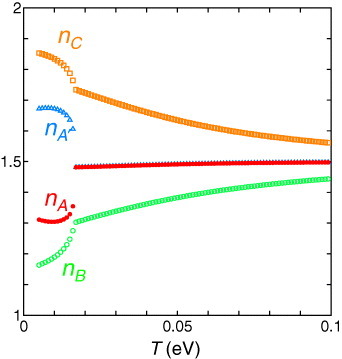
It is found that the DOS also reflects the inequivalence of the A (=A′), B and C sites. Figure [Citation15, Citation57] shows the DOS, ρα(ω), on each BEDT-TTF site α=A, A′, B, C in a unit cell, calculated using the data obtained by Kino and Miyazaki [Citation33], where . These four components exhibit linear energy dependences in the vicinity of the contact point. However, the inclination of ρC(ω) is much higher than that of ρB(ω), and that of ρA(ω) (=ρA′(ω)) has an intermediate value. This indicates that the site C mainly contributes to the ZGS. The inclinations of ρα(ω) affect the properties induced by low-energy excitations, such as the Knight shift K and the 1/T1 of the NMR experiments [Citation15, Citation58, Citation59].
Figure 5 Density of states (DOS) in the vicinity of the contact point on the BEDT-TTF sites A, A′, B and C, where ω=0 corresponds to the chemical potential [Citation15, Citation57].
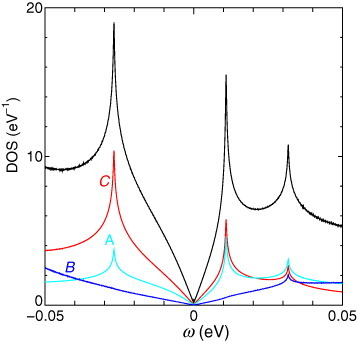
Zero-gap state
Dirac cone and electronic structure in the ZGS
Figure shows the energy dispersion of the conduction band ξ1 and the valence band ξ2 for U=0.4, Va=0.17, and Vb=0.05, where the lattice constant is taken as a=1 [Citation31]. The chemical potential coincides with the contact point at T=0. There are two contact points ±k0 because of the inversion symmetry. The linear dispersion exists within approximately 100 meV around the contact point. The velocity in the vicinity of the contact points is extremely anisotropic. The highest velocity is approximately ten times larger than the lowest velocity corresponding to the opposite direction of the highest velocity. Such a Dirac cone dispersion was found using the transfer energies given by the extended Hückel method on the basis of the data of the x-ray experiment [Citation27]. The global structure obtained using the transfer energies given by the first-principles calculation [Citation33] is similar to that of figure .
Figure 6 Energy dispersion of the conduction band ξ1 and valence band ξ2 (<ξ1), where the vertical axis represents the band energy in eV, on the kx–ky plane in radian [Citation57]. The chemical potential is taken as zero.
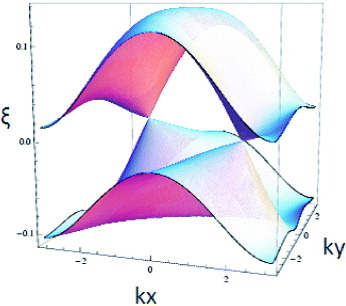
The gap does not open in the presence of the charge disproportionation with varying pressure, except in the case that two contact points merge with each other at high pressure [Citation34]. Figure shows the trajectories of the contact points when the transfer energies as the function of Pa are calculated using the data of Kondo et al [Citation27]. In the ZGS, the contact point moves from the cross (×) point (Pa=4.3 kbar) to the Γ point with increasing Pa along the solid line. At the phase transition from the ZGS to the charge-ordered state (at Pa=4.3 kbar), on the other hand, a pair of cones of the conduction and valence bands is split into two pairs of cones and gains the finite gaps simultaneously owing to the absence of the inversion symmetry and the spin-reversal symmetry [Citation57]. The momentum where the gap of a pair of the bands opens is different from that of another pair. The gap of a pair with a relatively large width remains near the location of the contact point for the ZGS (the × point). The gap of another pair with a small width, however, jumps into another × point in the vicinity of the M′ point. We note that the small electron and hole pockets emerge in the charge-ordered metal, because the energy of the former pair increases and the energy of the latter pair decreases. In the charge-ordered insulator, the widths of the gaps exceed those deviations of band energies. The smallest gap is located at the M′ point at pressures lower than Pa=3 kbar.
Figure 7 The solid curves show trajectories of a pair of contact points ±k0 that moves to the Γ-point with increasing Pa, where U=0.4, Va=0.17, and Vb=0.05 [Citation34]. The small ellipse of the solid line represents the electron and hole pockets for the charge-ordered metallic state at Pa=4 kbar. The dashed curves are obtained for the noninteracting case. The contact points also move from open-circle points (Pa=0 kbar) to the Γ point. The dashed curves around the X and Y points represent the electron and hole pockets, respectively, at Pa=0. The square, triangle and inverted triangle points correspond to Pa=10, 20, and 30 kbar, respectively (reproduced with permission from [Citation34]).
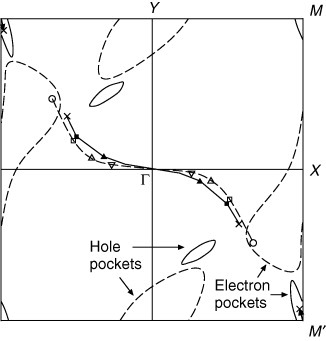
At high pressures, a pair of contact points approaches the Γ point, and then vanishes due to collision at Pa≅40 kbar. The electronic system becomes the Dirac fermion with finite mass at pressures higher than Pa≅40 kbar. The dashed curves in figure are obtained for the noninteracting case, where the contact point also moves from the open-circle point (Pa=0 kbar) toward the Γ point.
The momentum distributions of the charge density nα(k) exhibit a singularity in the vicinity of the contact point, reflecting the inequivalence of the BEDT-TTF sites A (A′), B and C [Citation34], where
The singularity comes from the angle-dependent wave functions of the massless Dirac fermions on these inequivalent BEDT-TTF sites, dαγσ(k), although the inversion symmetry exists for the equivalences of A and A′. Figure shows the momentum dependences of nA(k), nB(k) and nC(k) in the vicinity of the contact points [Citation57]. The singularity with antisymmetry is found in nB(k) and nC(k). The behavior of the momentum dependence in nB(k) is opposite to that of nC(k). On the other hand, nA(k) (=nA′(k)) is almost independent of k, since the A and A′ sites are equivalent. The total charge density
is, of course, independent of k. We emphasize that there are no singularities in nA(k) and nB(k) in graphene because the sublattices A and B are equivalent.
Figure 8 Momentum dependences of (a) nA(k) (=nA′(k)), (b) nB(k) and (c) nC(k) in the vicinity of the contact point k=k0 [Citation57].
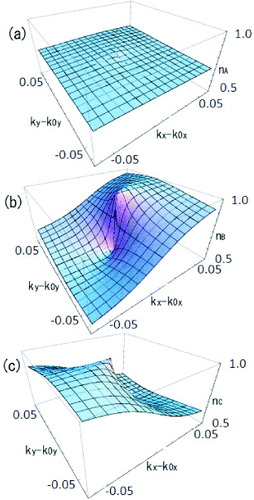
The anomaly of the charge densities nα(k) originates from the property of the wave function. In order to examine it, we start from a simple Hamiltonian
which consists of 2 sites in a unit cell. In the case of graphite [Citation41], a=b=0 and c=kx−iky. The diagonal components become equal (a=b) and the off-diagonal components vanish (c=0) at the contact point of the two bands. The wave functions (the eigenvectors) of the Hamiltonian depend on the phase θ, where c=|c|eiθ, i.e. θ is the angle of rotation around the contact point. The anomaly is discussed in terms of the helisity of the neutrino or the massless Dirac fermion in graphite. The wave function of the massless Dirac fermion can be described as that of the pseudo spin pointing a direction in the conducting plane. The helisity means that the pseudo spin is always parallel to the momentum k [Citation43]. Becasue the components of the wave function are the functions of the angle θ, the components of the wave function jump from θ to θ+π when k passes the contact point into −k. Such discontinuity is an intrinsic property of the massless Dirac fermions.
The instability of the massless Dirac fermions in the presence of the site potential is also understood using H(2). The diagonal components, which have different values in the presence of the site potential, violate the condition for degeneracy. Thus the massless Dirac fermions cannot exist in the system that consists of two inequivalent sites in the unit cell. For α-(BEDT-TTF)2I3, the massless Dirac fermions is robust against the charge disproportionation that originates from the inequivalency of the sites. It comes from the electronic system with four sites in a unit cell.
The unique properties of the ZGS in α-(BEDT-TTF)2I3 affect the electronic states in the vicinity of a nonmagnetic impurity [Citation57, Citation60] corresponding to the lack of anions [Citation61]. There appear the spatial incommensurate oscillation and anisotropy of the integrated DOS near the chemical potential in contrast to the case of graphene [Citation62–68].
We discuss the stability of the zero-gap fermion against interactions or symmetry breaking. When the Hamiltonian has both inversion symmetry and time-reversal symmetry and without the spin–orbit interaction, the accidental degeneracy can occur on a line in the 3D momentum space [Citation69]. The matrix representing the Hamiltonian can become real by unitary transform. Then two conditions, i.e. the diagonal elements are equal each other and the off-diagonal elements are zero, are required for degeneracy. The matrix becomes complex when either the inversion symmetry is broken or the spin–orbit interaction is finite. In this case, the degeneracy on the line disappears or remains on several points in the 3D momentum space [Citation70, Citation71]. The α-(BEDT-TTF)2I3 has the inversion symmetry, although the extremely small spin–orbit interaction is expected to cause a possible finite energy gap, this will be ignored at finite temperature.
Spin magnetism
In this subsection, we examine the spin magnetism of the ZGS [Citation15]. The spin susceptibility is described on the basis of four sites in a unit cell. The irreducible susceptibility is given by
where iδ (δ>0) is an infinitesimally small imaginary part. The local magnetic susceptibility (Knight shift of NMR), χα, and the NMR relaxation rate, T1, are obtained as [Citation72, Citation73]
respectively.
The local magnetic susceptibility and NMR relaxation rate for each site are shown in figures and , respectively, as a function of temperature. The calculation is performed using the transfer energies at T=0 of the data obtained by Kino and Miyazaki [Citation33]. The result obtained by taking the temperature dependences of the transfer energies into account is also shown for the total one (open circle) where such an effect of temperature is visible for T>0.005 eV. In figures and , reflecting the DOS, χC and (1/T1)C are the largest among the four sites. At low temperature, χα and (1/T1)α are proportional to T and T3, respectively, owing to ρα(∊)∝|∊|. The local physical quantities, χα and (1/T1)α, reflect the electronic states in the vicinity of the Fermi energy. The difference in the DOS of the A(=A′), B and C sites in figure , which originates from the inequivalency of these sites, directly corresponds to the magnitude of χα and (1/T1)α. (If all the sites in the unit cell are equivalent, χα and (1/T1)α are independent of the sites.) We note that the electron numbers on the A(=A′), B and C sites, nα, do not have direct correlation with the magnitude of χα or (1/T1)α, since nα is given by the integration of the DOS from the bottom of the bands to the Fermi energy. The results of the χα shown in figure are consistent with those of the NMR experiment [Citation17], and nα shown in figure is consistent with the x-ray experiment [Citation16]. The temperature dependence of the total 1/T1 is similar to that of the NMR experiment [Citation74, Citation75], although the temperature dependence exhibits a power being slightly different from 3. Such deviation may be attributable to the electron correlation effect.
Figure 9 Temperature dependences of χα (α=A,A′, B and C). The total value of χα is indicated by the solid line. The result of total one with the temperature dependence of the transfer energies is indicated by the open circles [Citation15].
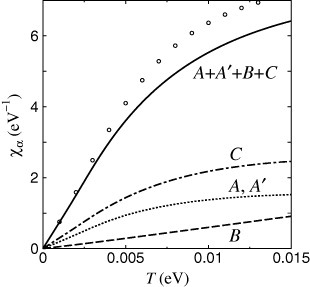
Figure 10 Temperature dependence of (1/T1)α. The notations are the same as in figure [Citation15].
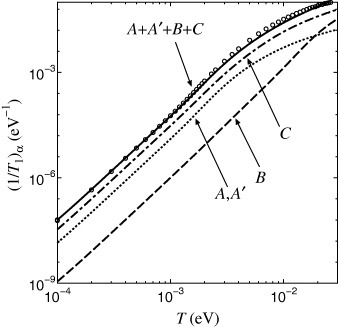
Tilted Weyl equation
In this subsection, we use the bases of Luttinger–Kohn representation [Citation76] to obtain the effective Hamiltonian in the ZGS [Citation34]. In the Luttinger–Kohn representation, the k dependences of the basis of wave functions are the same as the plane waves, because the periodic functions ukn(r) in the Bloch's functions φkn(r)=exp(ikr)ukn(r) with n being the band index are fixed on a constant momentum k=kc. In the present case, we take kc=k0′, where k0′ is infinitesimally close to the contact point k0 to avoid the discontinuity of the phase of the Bloch's functions at k0. Then we have the 4×4 matrix of the Hamiltonian, , where |γ〉 is the bases of Luttinger–Kohn representation with kc=k0′.
We can take the 2×2 part of the matrix corresponding to the conduction and valence bands and neglect other components when we describe the electronic states in the vicinity of the contact points. By making use of the expansion with respect to k, the Hamiltonian is given by
The momentum k is measured from k0′ hereafter. In the ZGS, H(0)=0 because the chemical potential coincides with the contact point. Then uγγ′≡〈γ|∇H(k)|k=0|γ′〉 is given by
where τ=x, y denotes the spatial direction. The real vectors vρ are defined as
respectively. Then we obtain the tilted Weyl equation [Citation34]
which is rigorous in the vicinity of the crossing point, where σ1, 2, 3 are the Pauli matrices, and σ0 is the identity matrix. We take the Planck constant
as
. The energy dispersions ξk±, corresponding to the conduction and valence bands, are obtained by diagonalization,
where ν=1, 2, 3.
The angles and the length of the velocities v1, v2, and v3 depend on the angle of the vector k0′−k0, although the resultant energy dispersion, of course, does not depend on the definition of k0′. Those degree of freedom originates from the degeneracy of the bands at the contact point. The relations between the velocities and the eigenvectors are discussed in the next subsection. When k0′−k0 is parallel to the x direction, we can take v0=(v0, 0), v1=0, v2=(0, vc) and v3=(vc, 0) approximately [Citation15], where vc=1.0×105 m s−1 and v0=0.8×105 m s−1 based on the transfer energies given by the first-principles calculation [Citation33].
Electronic structures close to the contact point
On the basis of the tilted Weyl equation, we examine the angle (θ) dependence of the eigenvectors of the mean-field Hamiltonian (equation (Equation3)), dαγ, where θ is the angle between k and the x-axis. We note that the eigenvector dαγ(k) depends only on the angle, θ, in the vicinity of the contact point.
Figure shows the θ dependence of |dα1| (a) and |dα2| (b) [Citation15]. There is a node in the components of the B site and C site, e.g. dB1(0)=0 and dC1(π)=0. For θ∼0, |dC1(θ)| is the largest, whereas |dD1(θ)| is the largest for θ∼π. For A and A′, |dα1(θ)| is almost constant. We note that there is a relation, |dα1(θ)|=|dα2(θ+π)|.
Figure 11 θ dependences of the absolute values of the eigenvectors of the mean-field Hamiltonian (equation (Equation3)), |dα1|(θ) in (a) and |dα2|(θ) in (b). The open circles are obtained from equation (Equation24
) [Citation15].
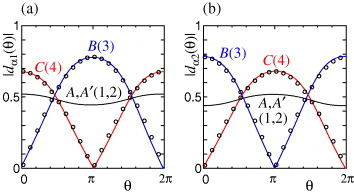
Here, we analyze the eigenvectors of the tilted Weyl equation. We discard the presence of v0, because it gives only the uniform shift of the eigenvalue and then the components of the eigenvector are independent of v0. By rewriting the tilted Weyl equation as
we obtain
for
and
, respectively, where kx=k cos θ, ky=k sin θ. The θ dependence of dαγ is obtained as
where uαγ=dαγ (k0′). This gives |dC1(θ)|=|dB2(θ)|≃0.67|cos(θ/2)| and |dB1(θ)|=|dC2(θ)|≃0.78|sin(θ/2)|. These analyses reproduce well the results shown in figure .
We compare the present result with that of the graphene. For the latter case, the Hamiltonian of equation (Equation22) is replaced by v(kxσ1+kyσ2), which gives the same eigenvalue but different eigenvector, where the absolute value of the component is independent of θ. The eigenvector of the graphene may correspond to the component of A and A′ of the present case, in which the θ dependence is small. Thus, it is found that the existence of the B and C components of the present case is the characteristic of the massless Dirac fermion of organic conductor α-(BEDT-TTF)2I3 in which there are four sites in the unit cell.
Anomalous transport phenomena and orbital diamagnetism
Conductivity, Hall conductivity, and orbital susceptibility in the tilted Weyl equation
In this subsection, we focus on the conductivity, the Hall conductivity, and the orbital susceptibility [Citation55] in the tilted Weyl equation [Citation34] obtained in the Luttinger–Kohn representation [Citation76]. The interband effects of the magnetic field are taken into account exactly in the Luttinger–Kohn representation [Citation47, Citation77]. The interband effects of magnetic field play crucial roles in the transport phenomena and the properties owing to orbital motion, such as the orbital diamagnetism [Citation45, Citation78–80]. The electronic states in periodic potential of the crystal are described using the Bloch bands ∊kn. One may think that the description of the electronic states in the presence of the magnetic field is realized by the substitution k→k+e/cA in ∊kn, where A is the vector potential. However, this is not justified, because A has matrix elements between different Bloch bands. Mathematically, this is because the Bloch's functions are not plane waves but contain periodic functions ukn(r). On the other hand, in the Luttinger–Kohn representation [Citation76], k dependences of the basis of wave functions are the same as plane waves, and then the substitution of k→k+e/cA is justified in the Luttinger–Kohn representation.
The conductivity and Hall conductivity are given by the Kubo formula,
where μ and ν denote x or y, and ωλ=2λπT is the Matsubara frequency. The current J is given by
, where
is the Hamiltonian with external magnetic field,
. The vector potential is expressed as a plane wave A(r)=exp(iqr)Aq.
The conductivity is given by
where G denotes the Green's function defined as
with the Matsubara frequency ∊n=(2n+1)πT, and G(+) denotes the Green's function with ∊n→∊n+ωλ. The effective spectrum broadening due to elastic impurity scatterings at T=0, Γ0, is taken into account phenomenologically here by
.
The Hall conductivity σxy with weak magnetic field is given by the first-order terms of the vector potential and momentum q. The gauge-invariant formula of the Hall conductivity in the Luttinger–Kohn representation is given by
The orbital susceptibility is defined as
The orbital susceptibility in the weak magnetic field is given as the Fukuyama formula [Citation78],
In the Luttinger–Kohn representation, we obtain γx=v0σ0+vcσ1 and γy=vcσ3 for the tilted Weyl equation.
The chemical potential (μ) dependences of σxx, σxy, and χ were calculated for graphene [Citation45]. The strong μ dependences of σxy and χ were found when μ is close to zero (the contact point). The tilting effects for σxx, σxy, and χ were calculated in the tilted Weyl equation [Citation55].
Figure shows the conductivities σxx, σxxa, and σxxb when the degrees of tilting α=v0/vc equal zero, where X=μ/Γ0 represents the chemical potential scaled by Γ0, and σxx=σxxa+σxxb. While σxxa is independent of X, σxxb exhibits weak X dependence in the vicinity of X=0 and is linear for |X|≫1. The finite value of the conductivity, e2/π2, at X=0 is a remarkable feature of the zero-gap fermion. The total conductivity σxx is weakly enhanced by tilting as shown in the inset, which is due to the enhancement of σxxb.
Figure 12 X dependences of total conductivity σxx (black line), σxxa (red line), and σxxb (blue line) when the degree of tilting α=0, where σxx0≡e2/2π2 [Citation55]. The inset shows X dependences of total σxx for several degrees of tilting.
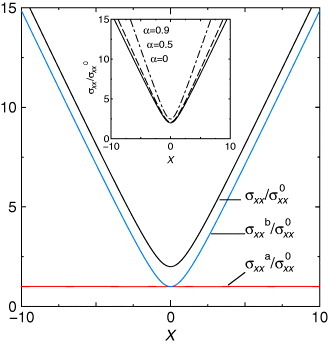
Figure shows the Hall conductivities σxy, σxya, and σxyb in the absence of tilting α=0, where σxy=σxya+σxyb. The contribution of the interband effects of the magnetic field, σxya, exhibits strong X dependences in the vicinity of X=0 within the energy scale of Γ0, and pass zero at X=0. The total Hall conductivities σxy for several degrees of tilting are shown in the inset. The Hall conductivity diverges when α=1. This divergence results from the integration over the Fermi surface extending to infinity. In the actual crystal, the divergence is suppressed by momentum integration in the finite Brillouin zone.
Figure 13 Hall conductivities σxy (black line), σxya (red line), and σxyb (blue line) in the absence of tilting, where σxy0≡e3vc2H/4π2cΓ02 [Citation55]. The inset shows X dependences of total σxy for several degrees of tilting.
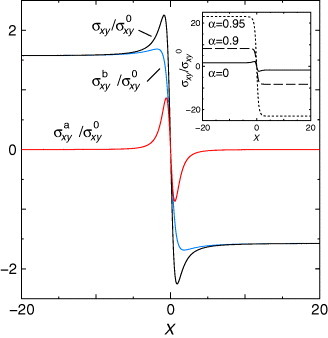
The enhancements of σxx and σxy by tilting are related to the decrease in the renormalized velocity in the presence of tilting [Citation52]. In addition, the roles of the interband effects of magnetic field in σxy were clarified by comparing with the intraband (Bloch) approximation [Citation80–84].
Hall effect and orbital diamagnetism
To investigate the temperature dependence of the Hall coefficient in α-(BEDT-TTF)2I3, the temperature dependence of the chemical potential μ is taken into account. The temperature dependence of μ based on the tight-binding model with transfer integrals fitted to the first-principles calculation [Citation33] is indicated by the dashed line in figure [Citation55]. In addition, the possible temperature dependence of the effective spectrum broadening due to the inelastic scattering is also taken into account phenomenologically, i.e. Γ0 is replaced by Γ=Γ0+θT, where θ is the coefficient of the linear term of T [Citation55]. Γ0=10−5 eV and θ=2×10−3 (dimensionless) are chosen hereafter. The three-dimensionality effects are taken into account by adding a term −2tz cos kzaz in addition to the tiled Weyl equation, where tz is the interlayer hopping and az is the layer spacing 1.74×10−9 m [Citation55]. The interlayer hopping tz creates the spindle-shaped Fermi pockets with electrons and holes along the crossing line as schematically shown in the inset of figure .
Figure 14 Temperature dependences of the chemical potential μ in the presence of electron doping (1.6 ppm) with Δμ=2.0×10−4 (solid red line), and in the absence of the carrier doping (dashed blue line) [Citation57]. The inset shows the spindle-shaped Fermi pockets with electron and hole along the crossing line due to the weak interlayer hopping.
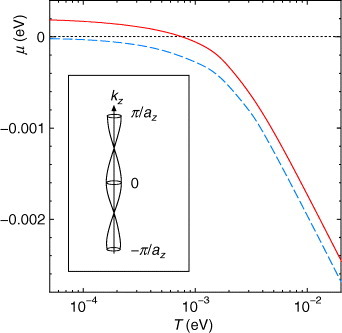
To explain the sign reversal of the Hall coefficient, we assumed the existence of electron doping, which is possibly induced by the lack of I3− ions [Citation55]. The solid line in figure shows the temperature dependences of μ in the presence of electron doping (1.6 ppm) with Δμ=2.0×10−4, where μ=Δμ at T=0. When electrons are doped, μ crosses zero at the finite temperature Tr. The value of Δμ=2.0×10−4 is chosen hereafter.
Figure shows the temperature dependences of the conductivity with tz=10−5, 3×10−5, 10−4, 3×10−4, and 10−3, where σxx0≡e2/2π2 [Citation85]. In the case with tz=10−3, the conductivity exhibits weak temperature dependence but the value at T→0 is much higher than σxx0. The temperature dependences of the conductivity become strong with decreasing tz. The conductivity decreases with decreasing T in the high-temperature region, and has a minimum at Tr and then weakly increases at temperatures lower than Tr. The minimum value of the conductivity is close to e2/π2 at tz=10−5, while the value has been studied as the quantum transport in graphene [Citation43, Citation45, Citation86]. In α-(BEDT-TTF)2I3, the conductivity close to e2/π2 has been observed at T=10 K (10−3 eV) [Citation49], indicating tz≅10−5. At temperatures lower than 10 K, however, it has been observed that the conductivity decreases with decreasing T. This decrease in conductivity may be due to the localization effect or the residual charge ordering.
Figure 15 Temperature dependences of the conductivity with tz=10−5 (the black line), 3×10−5 (the red line), 10- 4 (the orange line), 3×10−4 (the green line), and 10−3 (the blue line) where σxx0≡e2/2π2 [Citation57].
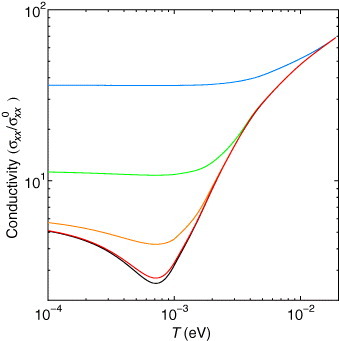
Figure shows the temperature dependences of the Hall conductivity with tz=10−5, 3×10−5, 10−4, 3×10−4, and 10−3, where σxy0≡e3vc2H/4π2cΓ02. In the case of tz=10−3, the Hall conductivity exhibits weak temperature dependence and the values at low temperatures are close to zero. The temperature dependences of the Hall conductivity become strong and exhibit a sharp sign reversal at Tr for small tz.
Figure 16 Temperature dependences of the Hall conductivity with tz=10−5 (black line), 3×10−5 (red line), 10−4 (orange line), 3×10−4 (green line), and 10−3 (blue line), where σxy0≡e3vc2H/4π2cΓ02 [Citation57].
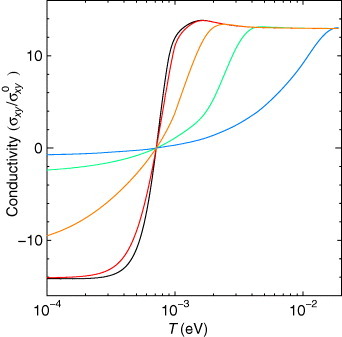
Figure shows the temperature dependences of the Hall coefficient R with tz=10−5, 3×10−5, 10−4, 3×10−4, and 10−3, where R=σxy/Hσxx2 with R0=π2vc2/ecΓ02. The Hall coefficient is strongly enhanced with decreasing T from room temperature to Tr. The sign of the Hall coefficient reverses continuously at Tr, because μ crosses zero. The sharpness of the reversal increases with decreasing tz. The maximum Hall coefficient at Tm also increases with decreasing tz, and then the maximum is 103 times larger than that at room temperature when tz is smaller than 10−4, which is in qualitative agreement with experimental observation in α-(BEDT-TTF)2I3 [Citation24]. The inset shows tz dependence of the half-width of the reversal, TW≡Tm−Tr. When tz is larger than Γ∼10−5, TW decreases with decreasing tz. When tz is smaller than Γ, on the other hand, the temperature dependences of the Hall coefficient are ruled by Γ, and then TW becomes independent of tz. Then tz must be comparable or smaller than Γ to explain the very sharp sign reversal observed in α-(BEDT-TTF)2I3 [Citation24].
Figure 17 Temperature dependences of the Hall coefficient with tz=10−5 (black line), 3×10−5 (red line), 10−4 (orange line), 3×10−4 (green line), and 10−3 (blue line), where R=σxy/Hσxx2 with R0=π2vc2/ecΓ02 [Citation57]. The inset shows tz dependence of the half-width of the reversal, TW=Tm- Tr.
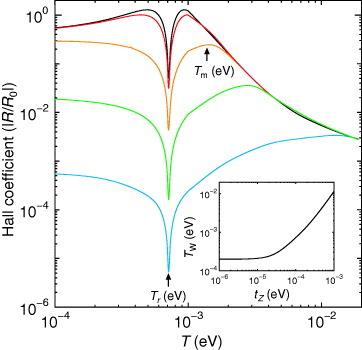
Figure shows the temperature dependences of the orbital susceptibility with tz=10−5, 3×10−5, 10−4, 3×10−4, and 10−3, where χ0≡−e2vc2/3π2c2Γ0. The temperature dependence becomes strong with decreasing tz. When tz is smaller than 10−4, a characteristic peak emerges at Tr and grows with decreasing tz.
Figure 18 Temperature dependences of the orbital susceptibility with tz=10−5 (black line), 3×10−5 (red line), 10−4 (orange line), 3×10−4 (green line), and 10−3 (blue line), where χ0≡−e2vc2/3π2c2Γ0 [Citation57].
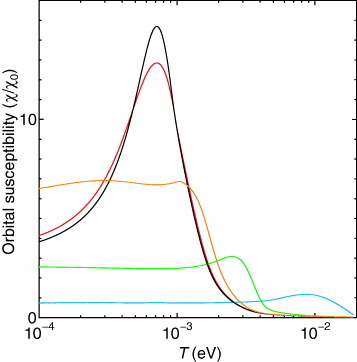
The electron-doping dependence of the Hall coefficient is shown in figure . The sign reversal of the Hall coefficient does not occur in the absence of the electron doping (dot-dashed line). The reversing temperature Tr increases as the electron doping increases. Surprisingly, it is theoretically predicted that the extremely small amount of electron doping, 1.6 ppm, gives Tr∼7 K, which is close to the experimental observations [Citation24].
Figure 19 Electron doping dependence of the Hall coefficient as a function of T, where the black, red, and blue lines are calculated with Δμ=2.0×10- 4 (1.6 ppm), Δμ=1.0×10- 4 (0.4 ppm), and Δμ=0 (0 ppm), respectively [Citation55].
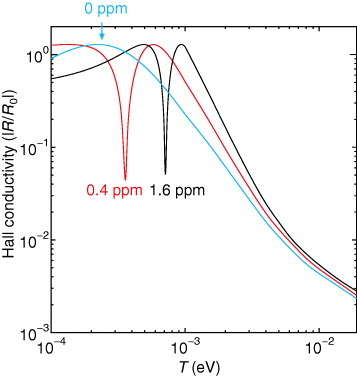
We emphasize that the sensitivities of the Hall coefficient and orbital diamagnetism as functions of temperature are essentially due to the interband effects of the magnetic field. However, the present results indicate that high two-dimensionality is required for the appearance of characteristic phenomena due to the two-dimensional zero-gap fermions. The interlayer hopping could be controlled using the uniaxial pressure perpendicular to the conducting plane, and then experiments on transport phenomena and orbital diamagnetism are expected by varying the uniaxial pressure along the c-axis in α-(BEDT-TTF)2I3 to observe the dimension crossover.
Summary
The existence of the ZGS with the massless Dirac fermions was found in α-(BEDT-TTF)2I3 [Citation30, Citation31], and the electronic properties have been investigated theoretically [Citation20, Citation28, Citation29, Citation34]. α-(BEDT-TTF)2I3 is a unique material among several materials with Dirac fermions, i.e. graphene, bismuth, and quantum wells such as HgTe. Those massless Dirac fermions are described by the tilted Weyl equation which consists of the identity matrix and the Pauli matrices. Within the extrapolation scheme of the transfer energies, the pair of the contact points ±k0 merges to disappear at high pressures, resulting in the Dirac fermions with finite mass as shown in the case of bismuth. The present massless Dirac fermions is robust against the pressure and charge disproportionation. The charge disproportionation originates from the inequivalency of BEDT-TTF sites, while the observed values of charge are reproduced by taking the interactions into account. The anomalous momentum dependence of the charge density in the vicinity of ±k0 is also obtained. The anomaly comes from both the property of the wave function of the massless Dirac fermions and the inequivalency of BEDT-TTF sites.
In addition, the conductivity, Hall conductivity and orbital susceptibility in the tilted Weyl equation were calculated [Citation55]. It is shown that these quantities have the same chemical potential dependences as those in the absence of tilting, where the Hall conductivity and orbital susceptibility are extremely sensitive to μ owing to the interband effects of magnetic field. These quantities are enhanced by tilting. Based on these results, the temperature dependence of the Hall coefficient is investigated by considering the temperature dependence of μ, which is estimated from the first-principles calculation of α-(BEDT-TTF)2I3 [Citation33] together with that of the spectrum broadening and the three-dimensionality. It is shown that temperature dependence of the Hall coefficient accounts for the general features observed in α-(BEDT-TTF)2I3 [Citation23]. To explain the sign reversal of the Hall coefficient [Citation24], the existence of electron doping is assumed which is possibly induced by the lack of I3− ions. A sharp but continuous sign reversal of the Hall coefficient at low temperature is found, which is in qualitative agreement with the experimental observations. These results indicate firmly the existence of the zero-gap fermion. It is predicted theoretically that the extremely small amount of electron doping, 1.6 ppm, gives a reasonable reversing temperature of the Hall coefficient, Tr∼7 K, which is close to the experimental observations. Moreover, the peak of the orbital diamagnetism around Tr as a function of temperature is predicted, where the maximum value of the orbital diamagnetism can be of O(10−2) of the perfect Meissner diamagnetism.
The roles of the interlayer hopping are also investigated in the conductivity, Hall conductivity, and orbital susceptibility. It is found that the continuous reversal of the sign of the Hall coefficient increases the sharpness with decreasing interlayer hopping. The interlayer hopping should be comparable or smaller than the effective spectrum broadening, expected as 10−5 eV, to explain very the sharp sign-reversal observed in α-(BEDT-TTF)2I3. On the other hand, the spin density wave is investigated theoretically for the case with large interlayer hopping [Citation87].
Lastly, the unique features of α-(BEDT-TTF)2I3 are expected to promote the original development that will shed light on new aspects of Dirac fermion physics. Particularly, the layered structure with highly two-dimensional massless Dirac fermions may exhibit new phenomena. Together with the effects of magnetic field, the layered structure is expected to affect the interlayer transport such as the interlayer Hall effect, electron correlation effects, and possible marginal Fermi liquid behavior with the resonance of polarization function.
Acknowledgments
We are indebted to R Kondo and S Kagoshima for providing the data of transfer energies in α-(BEDT-TTF)2I3 prior to their publication. We acknowledge H Fukuyama for encouraging us at the early stage of the work and also for the collaborative study on the tilted Weyl equation, Hall effect and orbital diamagnetism. We are also thankful to Y Fuseya, C Hotta, K Kajita, K Kanoda, H Kino, S Komaba, K Miyagawa, T Mori, S Murakami, T Nakamura, Y Nishio, K Noguchi, T Osada, H Seo, Y Shimizu, S Sugawara, N Tajima, T Takahashi, Y Takano, T Tohyama, K Yakushi, H Yamamoto, H Yoshioka, and G Montambaux for fruitful discussions. This work has been financially supported by a Grant-in-Aid for Special Coordination Funds for Promoting Science and Technology (SCF) from the Ministry of Education, Culture, Sports, Science and Technology of Japan, and for Scientific Research on Priority Areas of Molecular Conductors (No. 15073213) from the Ministry of Education, Culture, Sports, Science and Technology of Japan.
References
- IshiguroTYamajiKSaitoG 1998 Organic Superconductors 2nd edn Berlin Springer
- MoriH 2006 J. Phys. Soc. Japan 75 051003 http://dx.doi.org/10.1143/JPSJ.75.051003
- SeoHHottaCFukuyamaH 2004 Chem. Rev. 104 5005 http://dx.doi.org/10.1021/cr030646k
- BenderKHeningISchweitzerDDietzKEndresHKellerH J 1984 Mol. Cryst. Liq. Cryst. 108 359 http://dx.doi.org/10.1080/00268948408078687
- RothaemelBForroLCooperJ RSchillingJ SWegerMBelePBrunnerHSchweitzerDKellerH J 1986 Phys. Rev. B 34 704 http://dx.doi.org/10.1103/PhysRevB.34.704
- KinoHFukuyamaH 1995 J. Phys. Soc. Japan 64 4523 http://dx.doi.org/10.1143/JPSJ.64.4523
- SeoH 2000 J. Phys. Soc. Japan 69 805 http://dx.doi.org/10.1143/JPSJ.69.805
- HottaC 2003 J. Phys. Soc. Japan 72 840 http://dx.doi.org/10.1143/JPSJ.72.840
- TanakaYYonemitsuK 2008 J. Phys. Soc. Japan 77 034708 http://dx.doi.org/10.1143/JPSJ.77.034708
- TakanoYHirakiKYamamotoH MNakamuraTTakahashiT 2001 J. Phys. Chem. Solids 62 393 http://dx.doi.org/10.1016/S0022-3697(00)00173-6
- TakahashiT 2003 Synth. Met. 133–134 261 http://dx.doi.org/10.1016/S0379-6779(02)00404-6
- MorotoSHirakiK ITakanoYKuboYTakahashiTYamamotoH MNakamuraT 2004 J. Phys. IV France 114 339 http://dx.doi.org/10.1051/jp4:2004114096
- WojciechowskiRYamamotoKYakushiKKawamotoA 2003 Synth. Met. 135–136 587 http://dx.doi.org/10.1016/S0379-6779(02)00772-5
- WojciechowskiRYamamotoKYakushiKInokuchiMKawamotoA 2003 Phys. Rev. B 67 224105 http://dx.doi.org/10.1103/PhysRevB.67.224105
- KatayamaSKobayashiASuzumuraY 2009 Eur. Phys. J. B 67 139 http://dx.doi.org/10.1140/epjb/e2009-00020-0
- KakiuchiTWakabayashi SawaHTakahashiTNakamuraT 2007 J. Phys. Soc. Japan 76 113702 http://dx.doi.org/10.1143/JPSJ.76.113702
- TakanoYHirakiKTakahashiTYamamotoH M in preparation
- MaesatoMKagaYKondoRKagoshimaS 2000 Rev. Sci. Instrum. 71 176 http://dx.doi.org/10.1063/1.1150180
- TajimaNEbina-TajimaATamuraMNishioYKajitaK 2002 J. Phys. Soc. Japan 71 1832 http://dx.doi.org/10.1143/JPSJ.71.1832
- KobayashiAKatayamaSSuzumuraY 2005 J. Phys. Soc. Japan 74 2897 http://dx.doi.org/10.1143/JPSJ.74.2897
- KajitaKOjiroTFujiiHNishioYKobayashiHKobayashiAKatoR 1992 J. Phys. Soc. Japan 61 23 http://dx.doi.org/10.1143/JPSJ.61.23
- TajimaNTamuraMNishioYKajitaKIyeY 2000 J. Phys. Soc. Japan 69 543 http://dx.doi.org/10.1143/JPSJ.69.543
- TajimaNSugawaraSTamuraMNishioYKajitaK 2006 J. Phys. Soc. Japan 75 051010 http://dx.doi.org/10.1143/JPSJ.75.051010
- TajimaNSugawaraSTamuraMKatoRNishioYKajitaK 2007 private communication
- MoriTKobayashiASasakiYKobayashiHSaitoGInokuchiH 1984 Chem. Lett. 957 http://dx.doi.org/10.1246/cl.1984.957
- MoriTMoriHTanakaS 1999 Bull. Chem. Soc. Japan 72 179 http://dx.doi.org/10.1246/bcsj.72.179
- KondoRKagoshimaSHaradaJ 2005 Rev. Sci. Instrum. 76 093902 http://dx.doi.org/10.1063/1.2001607
- KobayashiAKatayamaSNoguchiKSuzumuraY 2004 J. Phys. Soc. Japan 73 3135 http://dx.doi.org/10.1143/JPSJ.73.3135
- KobayashiAKatayamaSNoguchiKSuzumuraY 2005 Physica B 359–361 451 http://dx.doi.org/10.1016/j.physb.2005.01.094
- KatayamaSKobayashiASuzumuraY 2005 The Physical Society of Japan March Conference Tokyo University of Science, 26pYL11
- KatayamaSKobayashiASuzumuraY 2006 J. Phys. Soc. Japan 75 54705 http://dx.doi.org/10.1143/JPSJ.75.054705
- IshibashiSTamuraTKohyamaMTerakuraK 2006 J. Phys. Soc. Japan 75 015005
- KinoHMiyazakiT 2006 J. Phys. Soc. Japan 75 034704 http://dx.doi.org/10.1143/JPSJ.75.034704
- KobayashiAKatayamaSSuzumuraYFukuyamaH 2007 J. Phys. Soc. Japan 76 034711 http://dx.doi.org/10.1143/JPSJ.76.034711
- WallaceP R 1947 Phys. Rev. 71 622 http://dx.doi.org/10.1103/PhysRev.71.622
- McClureJ W 1956 Phys. Rev. 104 666 http://dx.doi.org/10.1103/PhysRev.104.666
- SlonczewskiJ CWeissP R 1958 Phys. Rev. 109 272 http://dx.doi.org/10.1103/PhysRev.109.272
- KopelevichYMedina PantojaJ Cda SilvaR RMoehleckeS 2006 Ann. Phys., NY 321 1575 http://dx.doi.org/10.1016/j.aop.2006.04.002
- ZhengYAndoT 2002 Phys. Rev. B 65 245420 http://dx.doi.org/10.1103/PhysRevB.65.245420
- GusyninV PSharapovS G 2006 Phys. Rev. B 73 245411 http://dx.doi.org/10.1103/PhysRevB.73.245411
- AjikiHAndoT 1993 J. Phys. Soc. Japan 62 1255 http://dx.doi.org/10.1143/JPSJ.62.1255
- AndoTNakanishiTSaitoR 1998 J. Phys. Soc. Japan 67 2857 http://dx.doi.org/10.1143/JPSJ.67.2857
- AndoT 2005 J. Phys. Soc. Japan 74 777 http://dx.doi.org/10.1143/JPSJ.74.777
- NovoselovK SGeimA KMorozovS VJiangDKatsnelsonM IGrigorievaI VDubonosS VFirsovA A 2005 Nature 438 197 http://dx.doi.org/10.1038/nature04233
- FukuyamaH 2007 J. Phys. Soc. Japan 76 043711 http://dx.doi.org/10.1143/JPSJ.76.043711
- WolffP A 1964 J. Phys. Chem. Solids 25 1057 http://dx.doi.org/10.1016/0022-3697(64)90128-3
- FukuyamaHKuboR 1970 J. Phys. Soc. Japan 28 570 http://dx.doi.org/10.1143/JPSJ.28.570
- BernevigB AHughesT LZhangS C 2006 Science 314 1757 http://dx.doi.org/10.1126/science.1133734
- TajimaNSugawaraSTamuraMKatoRNishioYKajitaK 2007 Europhys. Lett. 80 47002 http://dx.doi.org/10.1209/0295-5075/80/47002
- SatoMMiuraKTajimaNKatoRNishioYKajitaK 2008 The Physical Society of Japan September Conference Iwate University, 22aTc10
- OsadaT 2008 J. Phys. Soc. Japan 77 084711 http://dx.doi.org/10.1143/JPSJ.77.084711
- GoerbigM OFuchsJ NMontambauxGPiechonF 2008 Phys. Rev. B 78 045415 http://dx.doi.org/10.1103/PhysRevB.78.045415
- KajitaKTajimaNEbina-TajimaANishioY 2003 Synth. Met. 133 95 http://dx.doi.org/10.1016/S0379-6779(02)00396-X
- KatayamaSKobayashiASuzumuraY 2006 J. Phys. Soc. Japan 75 023708 http://dx.doi.org/10.1143/JPSJ.75.023708
- KobayashiASuzumuraYFukuyamaH 2008 J. Phys. Soc. Japan 77 064718 http://dx.doi.org/10.1143/JPSJ.77.064718
- AndersonP W 1973 Mater. Res. Bull. 8 153 http://dx.doi.org/10.1016/0025-5408(73)90167-0
- KobayashiAKomabaSKatayamaSSuzumuraY 2008 J. Phys.: Conf. Ser. 132 012002 http://dx.doi.org/10.1088/1742-6596/132/1/012002
- KatayamaSKobayashiASuzumuraY 2008 J. Phys.: Conf. Ser. 132 012003 http://dx.doi.org/10.1088/1742-6596/132/1/012003
- ShiomiAYoshizakiSNakamuraTTakahashiTMurataK 1997 Synth. Met. 86 1975 http://dx.doi.org/10.1016/S0379-6779(97)80984-8
- KomabaS 2008 Master Thesis Department of Physics, Nagoya University, Japan
- MoriT 2007 private communication
- ShonB HAndoT 1998 J. Phys. Soc. Japan 67 2421 http://dx.doi.org/10.1143/JPSJ.67.2421
- KumazakiHHirashimaD S 2006 J. Phys. Soc. Japan 75 053707 http://dx.doi.org/10.1143/JPSJ.75.053707
- PeresN M RGuineaFCastro NetoA H 2006 Phys. Rev. B 73 125411 http://dx.doi.org/10.1103/PhysRevB.73.125411
- CheianovV VFal'koV I 2006 Phys. Rev. Lett. 97 226801 http://dx.doi.org/10.1103/PhysRevLett.97.226801
- KumazakiHHirashimaD S 2007 J. Phys. Soc. Japan 75 034707
- KumazakiHHirashimaD S 2007 J. Phys. Soc. Japan 75 064713
- WehlingT OBalatskyA VKatsnelsonM ILichtensteinA IScharnbergKWiesendangerR 2007 Phys. Rev. B 75 125425 http://dx.doi.org/10.1103/PhysRevB.75.125425
- HerringC 1937 Phys Rev. 52 365 http://dx.doi.org/10.1103/PhysRev.52.365
- WignerE Pvon NeumannJ 1929 Phys. Z. 30 467
- MurakamiS 2007 private communication
- MoriyaT 1963 J. Phys. Soc. Japan 18 516 http://dx.doi.org/10.1143/JPSJ.18.516
- SuzumuraY 1989 J. Phys. Soc. Japan 58 2642 http://dx.doi.org/10.1143/JPSJ.58.2642
- MiyagawaKKanodaK 2008 in preparation
- ShimizuYKobayashiAItoMYamamotoH MTakanoYTakahashiT 2008 in preparation
- LuttingerJ MKohnW 1955 Phys. Rev. 97 869 http://dx.doi.org/10.1103/PhysRev.97.869
- KuboRFukuyamaH 1970 Proc. 10th Int. Conf. Physics of Semiconductors Masachussets Cambridge (1970 United States Atomic Energy Commission 551)
- FukuyamaH 1971 Prog. Theor. Phys. 45 704 http://dx.doi.org/10.1143/PTP.45.704
- KohnoHYoshiokaHFukuyamaH 1992 J. Phys. Soc. Japan 61 3462 http://dx.doi.org/10.1143/JPSJ.61.3462
- FuseyaYOgataMFukuyamaH 2008 private communication
- LańdauL 1930 Z. Phys. 64 629 http://dx.doi.org/10.1007/BF01397213
- PeierlsR 1933 Z. Phys. 80 763 http://dx.doi.org/10.1007/BF01342591
- FukuyamaHEbisawaHWadaY 1969 Prog. Theor. Phys. 42 494 http://dx.doi.org/10.1143/PTP.42.494
- FukuyamaH 1969 Prog. Theor. Phys. 42 1284 http://dx.doi.org/10.1143/PTP.42.1284
- KobayashiASuzumuraYFukuyamaH to be published in Proc. 9th Int. Symp. Foundations Quantum Mechanics in the Light of New Technol.—ISQM-TOKYOf08 SIshioka KFujikawa Singapore World Scientific
- NomuraKMacDonaldA H 2007 Phys. Rev. Lett. 98 076602 http://dx.doi.org/10.1103/PhysRevLett.98.076602
- KatayamaSKobayashiASuzumuraY 2008 J. Phys. Soc. Japan 77 014710 http://dx.doi.org/10.1143/JPSJ.77.014710